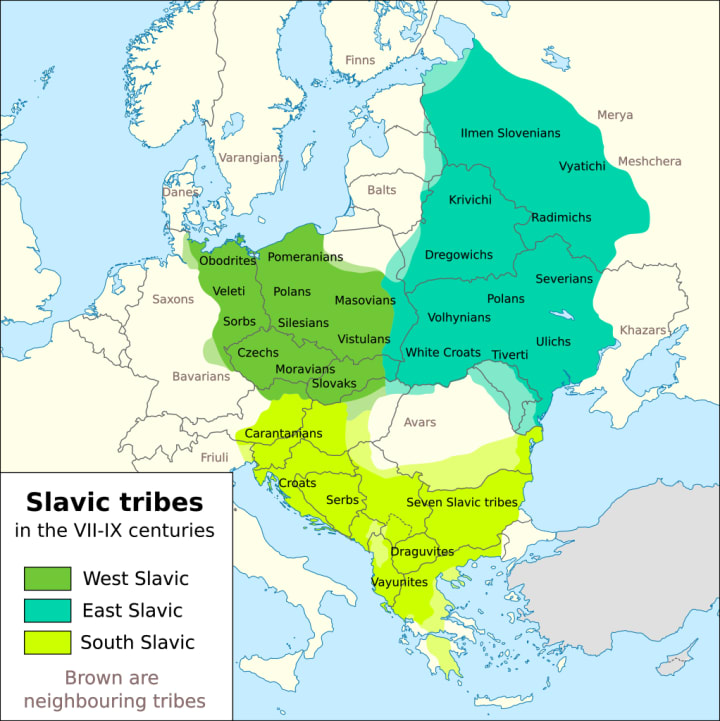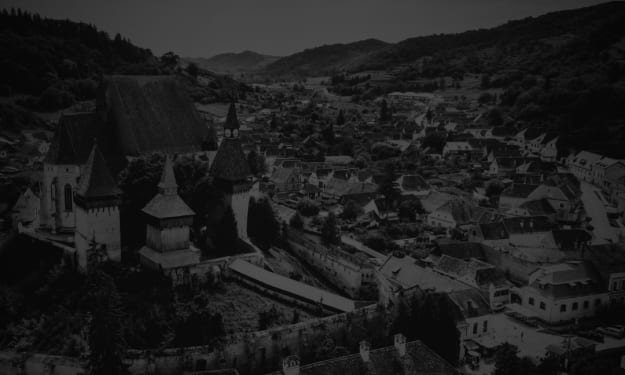Vila of Slavic Folklore
A nature spirit you don't want to insult.

Folklore is such an intriguing topic to dive into in any part of the world. In some cases, the folklore we know about today comes from an amalgamation of the entire history of a region—influences from different tribes, cultures, religions, and changing beliefs—creating a rich tapestry with threads connecting all over. Slavic folklore is an area that it's easy to get lost in because there's so much that's simply fascinating about it, from the unique creatures (or unique takes on them) to the sheer volume of branches of folklore to explore. We'll look at one of them now, a type of nature spirit that you never want to insult.
Brief History of Slavic Peoples & Folklore
The history of the people that folklore comes from helps us to understand the broader context surrounding tales of strange creatures. The Slavs have a compelling narrative woven with threads of migration, cultural evolution, and still somehow forging distinct identities under constantly changing geopolitical landscapes. There's no way to stuff the entire history of a people into a short article, so we'll take a brief look at the Slavic peoples from their earliest known origins.
Around the 5th century AD, tribes settled in Eastern Europe, particularly present-day Ukraine and Poland. These early Slavic communities were primarily agricultural, and their societal structures and beliefs were deeply entwined with the natural environment. The early inklings of Slavic folklore are deeply rooted in the pagan beliefs that flourished among the ancient Slavic tribes. Nature, seen as a living entity, often took center stage in these early narratives. The elements – earth, water, fire, and air, along with celestial bodies, were revered and personified through various mythological characters.
Over the centuries, various groups migrated, gradually expanding over a massive area of Europe, stretching from the Baltic in the north to the Balkans in the south. As the Slavic tribes migrated and interacted with other cultures, three distinct groups formed: East Slavic, West Slavic, and South Slavic. Each group developed its own unique linguistic, cultural, and political identity. The East Slavs gave rise to Russia, Ukraine, and Belarus; the West Slavs led to the formation of Poland, the Czech Republic, and Slovakia, while the South Slavs formed nations like Serbia, Croatia, and Bulgaria.

Christianity swept through the area between the 7th and 9th centuries AD, largely through missionary efforts, replacing Slavic paganism by claiming the Slavic traditions were actually really Christian and giving them Christian names and Jesusy-tweaks—oh, and lots of wars, aggressive politicking, and outright murder.

Despite the efforts to stamp out their cultural roots, the Slavs retained their stories and folklore. Today, there's a unique blend of traditions due to the centuries of influence—welcomed and unwelcomed.
The advent of Christianity in Slavic regions between the 7th and 9th centuries ushered in a phase of religious and cultural syncretism. The old pagan tales didn't fade away; instead, they intertwined with Christian narratives, birthing a unique blend of mythic storytelling. Saints, biblical characters, and Christian morals found their place alongside ancient pagan heroes, deities, and moral codes in this enriched tapestry of folklore.
By the late medieval period, Slavic folklore began to find expression in written literature and artistic endeavors. The 19th and early 20th centuries saw a folklore revival, with intellectuals and artists drawing deeply from folk traditions to foster national identity and creative innovation. Writers, poets, and composers like Alexander Pushkin and Antonín Dvořák delved into folklore, which brought more attention to the folk tales and breathed new life into the old traditions.
Unveiling the Vila
Within the rich tapestry of Slavic folklore, the ethereal figure of the vila holds a distinctive place, often embodying the myriad moods of nature—its beauty, mystery, and, at times, its wrath.

The "vila" is most often depicted as a beautiful woman who dwells in pristine corners of the natural world, from forests and meadows to rivers and lakes. Sometimes, they have wings, and tales say they possess supernatural healing abilities and the power of shapeshifting—which is quite fitting because they are said to be both benevolent and menacing toward humans—depending on the story.
Got "The Willies"?
Meyers Konversations-Lexikon defines "wilis" (from vilas) as female spirits or vampires representing betrothed girls who died before marriage. Known for their passion for dancing naked, particularly in town squares, they are depicted as restless souls luring young men at midnight to dance them to death. Regional variations include Serbian cursed maidens, Bulgarian unbaptized girls known as samodiva, and Polish beautiful girls atoning for frivolous past lives. Anglicized as "the willies", these eerie narratives led to the idiom "to give someone the willies." So, the next time you use this phrase, thank the Slavs.
When interacting with humans, they may turn into swans, falcons, horses, wolves, or any other creature from the natural world—even weather phenomena like whirlwinds. Some are said to roam the skies, playing pipes or drums from castles they've built on the edges of clouds. One of the worst things humans can do when interacting with a vila is insulting it somehow because we might end up dead or simply vanish, never to be seen again.
Occasionally, they're also described as riding horses or stags and may be found out in nature enjoying a hunt, dancing in circles, and sometimes looking for companionship of men.

Interestingly, in Slovene folklore, as described by F. S. Copeland, vilas (translated as 'White Ladies') appear as benevolent beings aiding women during childbirth and heroes in epic narratives, showcasing a more positive aspect of the vila—at least for women.
Echoes Around the World
If you think about the vila, it's probably easy to draw parallels to folklore all over the world. Here are a few similar tales from other cultures that will likely leave you wondering how these stories developed independently.
In ancient Greek mythology, nymphs personify aspects of nature. Often depicted as beautiful maidens, they reside in forests, mountains, and waters, interacting with gods, humans, and the environment. Their stories blend beauty, allure, and a raw, natural essence similar to the vila's narrative—sometimes benevolent and sometimes quite dangerous to unsuspecting humans.
Celtic folklore has a wide range of nature spirits, notably (for this context) fairies and the Sidhe. Much like the vila, these beings embody nature's whimsical aspects, sometimes benevolent, at other times malevolent. Their narratives explore the fine line between the earthly and the ethereal, weaving a tapestry of mysticism closely aligned with the natural world.
In Scandinavian folklore, the Huldra is a forest spirit, often depicted as a beautiful woman, much like the vila. The Huldra are known to have both benign and sinister facets, depending on how humans encounter and treat them. I'm sure this sounds familiar.

Drawing parallels from Japanese folklore, the Yama-uba, a yōkai, embodies a blend of nurture and menace reminiscent of the vila's multifaceted character. Though often depicted as an old woman, the Yama-uba shares the vila's close association with nature, its unpredictability, and sometimes helpful and occasionally deadly interactions with human beings.
In modern times, Slavic folklore persists in so many forms. It has and continues to inspire literature, film, music, and even video games, asserting its enduring appeal across time. From classical ballets to contemporary fantasy fiction, Slavic folklore's elemental themes and ethereal characters continue to enchant us all.
Relevant & Related
- Learn about the History and Mythology of the Slavs.
- Read Prince Marko and the Vila online.
- Watch the History channel's short lesson on the Origins of Christmas.
- Check out this awesome video with snippets of all the Slavic languages so you can hear the differences. Even more on the Slavic languages on Langfocus in The Slavic Languages and What Makes Them a FAMILY.
- Meeghan Reads has a wonderful list of Books Inspired by Slavic lore.
- Learn even more about the Vila of Slavic Mythology from Chekhov's Pistol on YouTube and another take from Brendan Noble Author's Slavic Mythology Saturday.
- Read Myths of the Norsemen From the Eddas and Sagas by H. A. Guerber (complete with images!) on Project Gutenberg.
- If you enjoyed this, check out these other articles: Vântoase of Romanian Folklore | Leannán Sídhe of Irish Folklore | Glaistig of Scottish Folklore | Kuchisake-onna, the Slit-Mouthed Woman of Japanese Folklore | The True Story of Arnold Paole, Vampire of Meduegna, Serbia
~
Originally published in my weekly newsletter, Into Horror History - every week, I explore the history and lore of horror, from influential creators to obscure events. Cryptids, ghosts, folklore, books, music, movies, strange phenomena, urban legends, psychology, and creepy mysteries.
About the Creator
J.A. Hernandez
J.A. Hernandez enjoys horror, playing with cats, and hiding indoors away from the sun. Also, books. So many books—you wouldn't believe.
He runs a weekly newsletter called Into Horror History and writes fiction.
https://www.jahernandez.com






Comments (1)
So, that's where "Gives me the willies" comes from. That's very interesting. Despite the geographical differences, there are a lot of common themes in folklore. Fascinating.